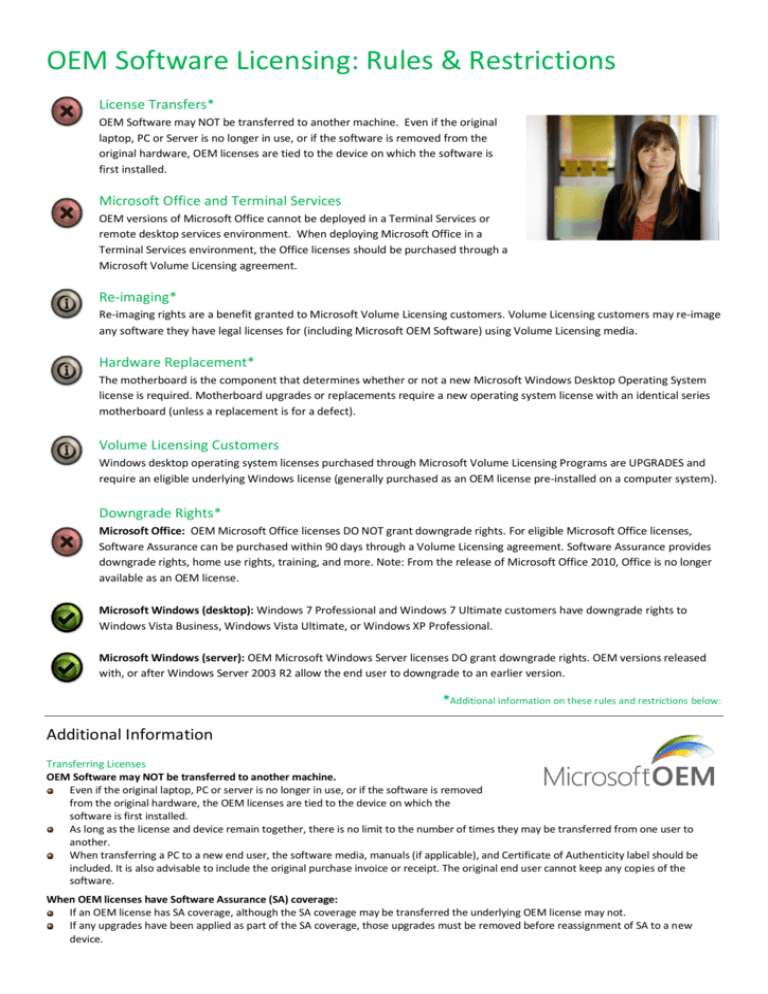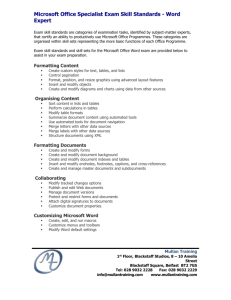
OEM Software Licensing: Rules & Restrictions
License Transfers*
OEM Software may NOT be transferred to another machine. Even if the original
laptop, PC or Server is no longer in use, or if the software is removed from the
original hardware, OEM licenses are tied to the device on which the software is
first installed.
Microsoft Office and Terminal Services
OEM versions of Microsoft Office cannot be deployed in a Terminal Services or
remote desktop services environment. When deploying Microsoft Office in a
Terminal Services environment, the Office licenses should be purchased through a
Microsoft Volume Licensing agreement.
Re-imaging*
Re-imaging rights are a benefit granted to Microsoft Volume Licensing customers. Volume Licensing customers may re-image
any software they have legal licenses for (including Microsoft OEM Software) using Volume Licensing media.
Hardware Replacement*
The motherboard is the component that determines whether or not a new Microsoft Windows Desktop Operating System
license is required. Motherboard upgrades or replacements require a new operating system license with an identical series
motherboard (unless a replacement is for a defect).
Volume Licensing Customers
Windows desktop operating system licenses purchased through Microsoft Volume Licensing Programs are UPGRADES and
require an eligible underlying Windows license (generally purchased as an OEM license pre-installed on a computer system).
Downgrade Rights*
Microsoft Office: OEM Microsoft Office licenses DO NOT grant downgrade rights. For eligible Microsoft Office licenses,
Software Assurance can be purchased within 90 days through a Volume Licensing agreement. Software Assurance provides
downgrade rights, home use rights, training, and more. Note: From the release of Microsoft Office 2010, Office is no longer
available as an OEM license.
Microsoft Windows (desktop): Windows 7 Professional and Windows 7 Ultimate customers have downgrade rights to
Windows Vista Business, Windows Vista Ultimate, or Windows XP Professional.
Microsoft Windows (server): OEM Microsoft Windows Server licenses DO grant downgrade rights. OEM versions released
with, or after Windows Server 2003 R2 allow the end user to downgrade to an earlier version.
*Additional information on these rules and restrictions below:
Additional Information
Transferring Licenses
OEM Software may NOT be transferred to another machine.
Even if the original laptop, PC or server is no longer in use, or if the software is removed
from the original hardware, the OEM licenses are tied to the device on which the
software is first installed.
As long as the license and device remain together, there is no limit to the number of times they may be transferred from one user to
another.
When transferring a PC to a new end user, the software media, manuals (if applicable), and Certificate of Authenticity label should be
included. It is also advisable to include the original purchase invoice or receipt. The original end user cannot keep any copies of the
software.
When OEM licenses have Software Assurance (SA) coverage:
If an OEM license has SA coverage, although the SA coverage may be transferred the underlying OEM license may not.
If any upgrades have been applied as part of the SA coverage, those upgrades must be removed before reassignment of SA to a new
device.
Regarding transferring SA for Microsoft Windows Desktop Operating System licenses:
The new device must have the latest (commercially available) version of the Microsoft Windows Desktop Operating System before the
Software Assurance coverage is transferred and applied.
Re-imaging
Re-imaging rights are a benefit granted to Microsoft Volume Licensing customers. Microsoft Volume Licensing customers may use Volume
Licensing media to re-image software (including OEM Software licenses) under the following conditions:
The copies re-imaged from the Volume Licensing media are identical to the originally licensed product (the same product and version,
contain the same components, and are in the same language).
The customer must purchase at least one unit of the product required to be re-imaged through their Volume Licensing agreement in
order to obtain access to the product media and receive a key.
Volume Licensing media must be used for re-imaging (OEM media may not be used).
Deploying the Image:
Volume Licensing customers may be prompted to use a Volume Licensing key (VLK).
VLKs should be automatically assigned through the Volume Licensing Service Centre (VLSC)
http://www.microsoft.com/licensing/servicecentre
If there is any trouble with accessing VLKs, the keys may be requested via the Activation Call Centre on 0800 676 334.
Important Note: There are some products such as Microsoft Windows 7 Enterprise and Microsoft Office Professional Plus 2010 which are
not available outside of Volume Licensing programs, and therefore are not eligible for re-imaging.
Downgrade Rights
Downgrade rights refer to the ability of customers to acquire the most recent version of Microsoft software but continue to run a previous
version until they are ready to upgrade.
Microsoft Office:
OEM versions of Microsoft Office software licenses DO NOT grant downgrade rights.
To get access to downgrade rights, Software Assurance (SA) is available to purchase for underlying OEM Office Professional licenses
within 90 days from the date of the OEM purchase. Software Assurance is only available through a Microsoft Volume Licensing
agreement.
Microsoft Windows Desktop Operating System:
OEM versions of Microsoft Windows licenses DO grant downgrade rights.
Windows 7 Professional and Windows 7 Ultimate customers have downgrade rights to Windows Vista Business, Windows Vista Ultimate,
or Windows XP Professional.
To downgrade, the customer must supply media to the OEM System Builder. The media must come from a legally licensed version of the
product that has been purchased via Microsoft retail, OEM/System Builder, or Volume Licensing channels.
Microsoft Software Assurance can be purchased within 90 days of the OEM Software purchase. Software Assurance offers business
benefits such as e-Learning, training vouchers and access to Windows 7 Enterprise. Windows 7 Enterprise offers access to great additional
technology including DirectAccess, BitLocker, and Microsoft Desktop Optimisation Pack.
Microsoft Windows Server:
OEM versions of Microsoft Windows Servers licenses DO grant downgrade rights.
OEM versions released with, or after Windows Server2003 R2 allow the end user to downgrade to an earlier version.
To downgrade the customer must supply media to the OEM System Builder. The media must come from a legally licensed version of that
product purchased via Microsoft retail, OEM/System Builder, or Volume License channels.
Microsoft Software Assurance can be purchased within 90 days of the OEM Software purchase. Software Assurance on Server Products
offers business benefits such as new version rights, e-Learning, access to step ups, cold 24 x 7 problem resolution support and more.
Hardware Replacement
Generally an end user can upgrade or replace all of the hardware components on a computer, except the motherboard, and still retain
the license for the original Microsoft OEM Windows Desktop Operating System software.
If the motherboard is upgraded or replaced for reasons other than a defect, then a new computer has been created. Microsoft OEM
Windows Desktop Operating system software cannot be transferred to the new computer, and new operating system software is
required.
If the motherboard is replaced because it is defective, you do not need to acquire a new operating system license for the PC as long as the
replacement motherboard is the same make/model or the same manufacturer’s replacement/equivalent, as defined by the
manufacturer’s warranty.
The reason for this licensing rule primarily relates to the End User Software License Terms and the support of the software covered by
that End User Software License Terms. The End User Software License Terms is a set of usage rights granted to the end user by the PC
manufacturer and relates only to rights for that software as installed on that particular PC.
The System Builder is required to support the software on the original PC. Understanding
that end users, over time, upgrade their PCs with different components, Microsoft needed to have one base component “left standing”
that would still define the original PC. Since the motherboard contains the CPU and is the “heart and soul” of the PC, when the
motherboard is replaced (for reasons other than defect) a new PC is essentially created. The original System Builder did not manufacture
this new PC, and therefore cannot be expected to support it.
Need more information on OEM Software Licensing?
Please consult your preferred Microsoft OEM System Builder or Microsoft Reseller
This document is for informational purposes only. Microsoft makes no warranties express or implied in this document. If there is any conflict between this
document and Microsoft license terms, the license terms govern.© 2011 Microsoft Corporation. All rights reserved.







